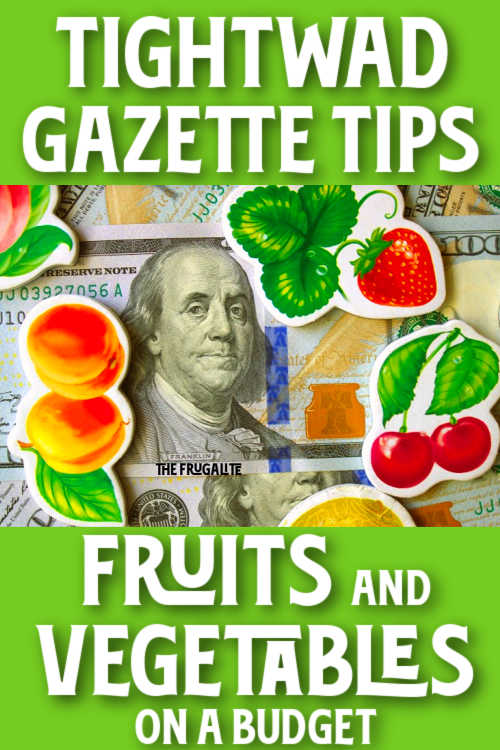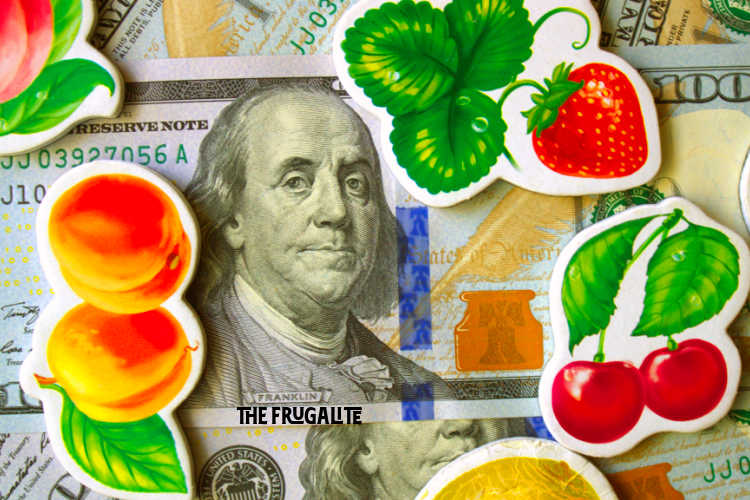(Psst: The FTC wants me to remind you that this website contains affiliate links. That means if you make a purchase from a link you click on, I might receive a small commission. This does not increase the price you’ll pay for that item nor does it decrease the awesomeness of the item. ~ Daisy)
The Tightwad Gazette is a most wonderful publication! It contains pointers on just about everything under the sun and is well-indexed. Reading the sections on gardens and gardening got me thinking about fruits and vegetables, and sure enough, there’s an entire section for that!
How can we obtain healthy fruits and vegetables without busting our budget, especially now?
As an aside, Collette’s article on Food Cooperative buying groups (closely related to CSA boxes) comes to mind. As some may know, CSA is Community Supported Agriculture. What one does is purchase a share of a farmer’s crop, to be delivered at specified intervals.
My CSA delivers to my door, while others require members to pick it up at a central location. Item selection is usually what the farmer is growing, so one may well receive items that one does not care for. For example: green and wax beans are very commonly grown in my area. They come in my box regularly, but after one season working the green bean line at the canning factory, I’ll have to be nearly starving before I’ll touch another one! This is a drawback of the CSA box: the inability to choose one’s preferred vegetables.
I give mine to the food bank or my neighbors (along with eggplant), and really, this is more the exception than the rule. I have the small box, produce for 1-2 people. It costs $31 per box delivered, not the cheapest option, but I’ve never been dissatisfied with the quality or amount of produce. I also enjoy paying my local family farmer directly. This cuts out several middlemen and supports my local economy, including the family farm.
Here are suggestions from The Tightwad Gazette
Back to the main topic! What does The Tightwad Gazette have to say about getting healthy fruits and vegetables on the cheap? Lots, of course!
One reader writes in about bargaining at farmer’s markets. She shops around to find the vendors with the best prices, then offers to take a bushel or two at half of the price they’re offering. Rationale: food doesn’t stay fresh for long, and the farmer likely doesn’t want to pack it back home, so according to her, they often agree to her price.
Keep in mind that buying in bulk is for canning/preserving. Buying in bulk often costs less per unit, and food so preserved will last over the course of the year. So why not at least ask for the bargain? All they can say is no. They may come back with another price, and the bargaining is on! Chances are that both you and the farmer will walk away happy.
So how about that canning stuff?
Amy gives some tips and points on pages 657-660, including a recommendation on one of the most seminal volumes in the trade: The Ball Blue Book of Preserving. If you’ve never canned before, an instruction manual is a must! Even if you’re an old pro, this book is most helpful. The Blue Book contains information on equipment, sanitation, and of course, recipes. It’s a bit more than the $3.50 it was when this issue came out, but it’s well worth the price.
I bought my first copy in 2012 for about $20. I just purchased the updated version for about the same. The Blue Book also contains information about freezing and dehydration. I cannot recommend it enough! You may also enjoy Daisy’s book on canning.
Along with some myth-busting, Amy discusses ways to get equipment cheaply or outright free. Jars are especially easy to acquire. Amy suggests asking friends or putting an ad in the local free shopper. These days the freecycling movement might be of assistance. Check out what’s available in your area by searching here. Equipment was a fairly hefty investment for me since I did buy mine new. I have, however, used those things every single year since my purchase.
Jars do break over time, and lids require replacing. While many do reuse metal lids, others do not and both the USDA and lid manufacturers recommend not reusing them. My Grandma did, and I’ve lived to tell the tale. Your kitchen, your rules. Tattler aka Harvest Guard, are made to be reused. Do your due diligence, please. Other places one might acquire equipment and jars are garage sales, estate sales, and thrift stores. I helped my father auction off many old estates and saw cases worth of old jars among the goodies. Canner gauges can be easily acquired for that old pressure canner, and many hardware stores offer a calibration service. Old rubber seals are very cheap and easy to replace as well.
How about that outdated produce from the grocery store?
Overripe bananas, for example, are perfect for making banana bread! I make several loaves of quick breads and freeze them, then use them over the winter as needed. Pages 689-690 discuss experiences with obtaining this stuff from grocery stores. The basic tactic is to sidle up to the produce manager and ask what happens to outdated fruits and vegetables. Some stores give it to food banks, others just toss it, and others either put it out on carts occasionally or will make private arrangements with individuals to sell the stuff on the cheap.
Keep in mind that these things won’t last long in your kitchen either, so the main idea is to acquire cheaply, then preserve for later use. Use the information in the Blue Book to can, freeze, or dehydrate your treasures! Amy also notes that chain grocery stores may have different policies from independents. One of a kind mom & pop stores may not even have a produce section, but they may have other things worth asking about, such as deals on meat. A simple conversation can yield many benefits, for all parties! (We have an article on last-day-of-sale items here, too.)
So there we have it: a few more gems from the past for frugal living today.
Healthy fruits and vegetables can be SO expensive! However, these are a very necessary part of a balanced diet. The processed versions, while cheaper, also contain many chemicals, sometimes even more chemicals than actual food. By using these strategies, we can eat well on the tightest of budgets.
How do you obtain fresh fruits and vegetables on the cheap? How do you preserve them? Please tell us in the comments section below!
About Amy Allen
Amy Allen is a professional bookworm and student of Life, the Universe, and Everything. She’s also a Master Gardener with a BS in biology, and has been growing food on her small urban lot since 2010.












4 thoughts on “Tightwad Gazette Tips: Fruits and Vegetables on a Budget”
I must have the same edition of the Tightwad Gazette since my pages starting at 657 about canning are the same as mentioned above. What that author doesn’t address is the huge difference in nutrition preservation that results from dehydration. I learned from Tammy Gangloff via her website https://www.dehydrate2store.com/ and her books that while canning preserves roughly half of the nutrition present in freshly picked produce … dehydration preserves about 90% of that nutrition. There is a small minority of fruits and vegetables that don’t respond well to dehydration attempts but the vast majority of types do.
Dehydration requires some different equipment — a dehydrator (whether electric or solar), a vacuum sealer, a supply of plastic bag material, and a supply of oxygen absorbers. The 2011 Kindle book titled The Complete Vacuum Sealer Guide by Roger Seher on Amazon.com covers some invaluable how-to information.
–Lewis
I’m gardening at my property and planning to rework a 30 to 40 year unused large garden site on a friend’s property. I’ve also been eating most weekdays at a senior center with a hot lunch for anyone over 60. Lots of vegetables and usually a fruit and always a protein. I also get food from a community pantry. My income just falls within the guidines to get free food there. Vegetables and fruits depend on whatever they receive. There is usually some meat, dairy, and canned goods of some sort. Sometimes a lot of food and lately not so much but it all helps. I can the excess from all sources. I’m helping my friend where I’m restoring the old garden and pass on some produce to a friend who often has her 5 grandkids to feed.
I’m adding more fruits and perennial vegetables at my friends place. I’ve added some perennials such as asperigus and berries on my property and also wild fruit trees. I also plant wild foods that freely self seed.
The older I get the more I appreciate things that take less and less physical work. At 76 I’m aware of needing to stay busy to maintain health and strength but I know I’ll have less and less to put into food production as time goes by.
I’m replanting 45 strawberries split between 2 properties this spring. Also adding 50 new 1 year old asperigus roots split between the 2 properties. My friend is donating tractor work, aged horse manure and vehicle maintainance ect. He’s buying many fruit trees and berry bushes to set out on his property. I’ll help with planting and caring for them inexchange for canning fruits to split between us. I can survive ok with what’s on my property but this will offer us both a bigger variety. Sharing with others can also benefit you. If there happens to be more of anything than we will can, sun dry, dehydrate, or freeze it is mine to give away, trade, or sell at the local farmers market. I’m the heirloom seed saver and grower. My garden is set up to use mostly saved rainwater. His garden is using a mix of well and municipal water. He has rain gutters and I have excess barrels and 330 gallon caged water containers. Guess who will soon be using rain water? I do work while he adds both spending and work. I’ve been gathering things for years so little was spent getting containers, used wood, stepping stones, cinder blocks, bricks, chickens, rabbits, tools ect. My home is 100% solar. My excess solar supplies are going into 2 sons homes and perhaps my friends home as back up as well.
This winter my friend bought a camp trailer and drove about 4,000 miles taking us to the eastcoast to visit our daughters for most of a month. All I did was play navigator and find cheap fuel. He paid for everything. He’d never taken a vacation before and enjoyed it so much he’s bought a bigger trailer and is planning more travels. It all started out as a way for us to both have more fruits and vegetables. Better meals is still our health focus.
I try to spend my money supporting local businesses. Everything we do to help locally helps us as well.
Great post!
I decided I’d preserve whatever items I receive for free. Last year I made lemon marmalade, dehydrated lemon slices, canned plums, a big bag of beets was turned into pickled beets and beet relish, and there were smaller amounts of fruit and veggies I was able to use fresh. Most comes from a lady who works in the veggie/fruit distribution field through a friend. My green thumb has turned a little brown but my garden provided some tomatoes, cucumbers, yellow squash, and zucchini. I’ve also purchased tomatoes from several different growers. Sometimes they’ve had extra other veggies they’ve thrown in for free. Most farmers markets in my area charge more than my budget can afford and often sell out of the things I might use. We do have a local ranch that has a big stand where I’ve gotten cucumbers and green/yellow beans in a quantity to preserve. I have Daisy’s canning cookbook and have used several of her recipes.